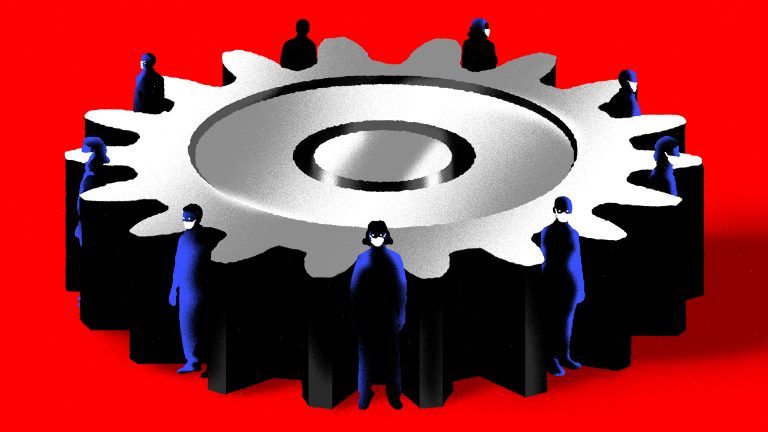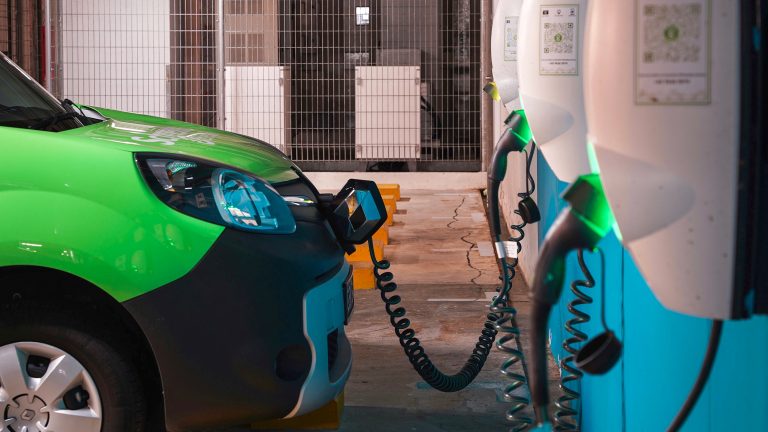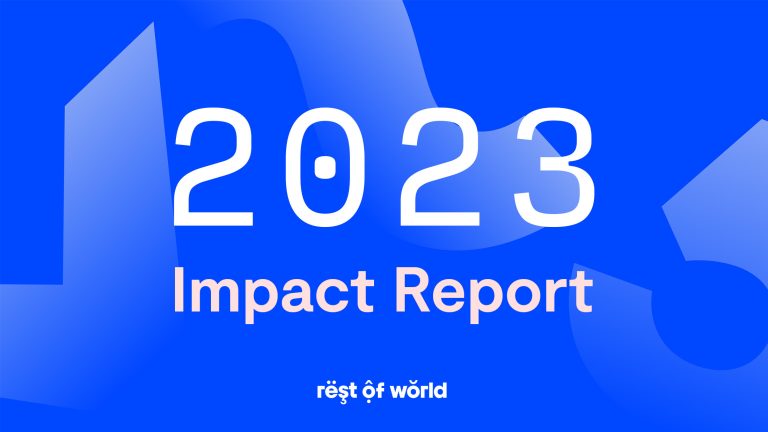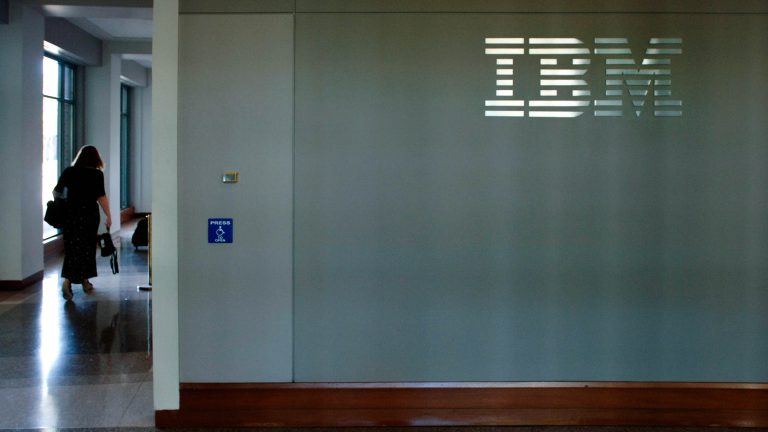When an excited buyer tears open the box of a brand-new Samsung phone, the last hands to touch it were likely in an industrial park in northern Vietnam. The country is Samsung’s biggest production base in the world, churning out the South Korean company’s mobile phones and tablets in the north, and consumer electronics like washing machines and fridges in the south.
Tens of thousands of Samsung’s workers live in bare, sterile dorms, or cramped rental accommodation that, in the 2010s, sprang up out of the rice fields surrounding the factories. Most have left behind parents in the countryside, lured by the prospect of stability and better pay in the industrial zones. Drive through, and you’ll see the logos of huge companies like Canon and Foxconn, the major Apple supplier, splashed across signboards.
Throughout 2020 and the early part of this year, Vietnam had famously — and inexplicably — seemed to repel the coronavirus. Its electronics exports were soaring. But by the end of May, Covid-19 cases began to spike; clusters formed around the manufacturing hubs to the north, and life in the cities and production centers, which had been humming largely as normal, began to falter.
Major technology companies, already burdened by supply chain disruptions in other parts of the world, couldn’t afford to halt production in Vietnam. Instead, they kept their factories going by any means possible: sequestering workers, subjecting them to strict virus controls, spending heavily on accommodation, raising wages — even, in some cases, securing early vaccine access.
As shoppers in the West were told their gadgets would probably not arrive in time for Christmas this year, thanks to a global shortage of chips and snarled shipping ports, the Vietnamese government effectively gave factory owners an ultimatum: Shut down, or find a safe way to isolate your workers from the rest of the population. Around the end of May, employees at Samsung Display in Vietnam’s industrial Bac Ninh province were given a similar choice: Stay home without shifts, or move into a company-designated space and keep those jobs — with a little extra pay, according to some workers, as an added sweetener.
Nam, an easygoing 23-year-old who works in the environmental safety department, chose the latter. He didn’t have much to lose. Days later, he and more than a dozen of colleagues found themselves in a nearby school, in an abandoned classroom with no beds, fans or air-conditioning in the sweltering 38-degree Celsius (100.4-degree Fahrenheit) summer heat. Few of his colleagues wore masks.
“In there, the phone was my only friend,” Nam told Rest of World. His name, and those of other workers, have been changed to protect them from reprisals.
Workers complained for two days. Then, they were moved onto the factory’s premises. The lines between their workplace and home evaporated. For nearly three weeks, Nam slept with a blanket on a mattress in a warehouse alongside around 100 other male colleagues, moving between there, the company canteen and the production line in what felt like a twilight of unending work. His life revolved around screens. As the factory’s main product, they gave him his livelihood. Come rest time, his attention would narrow into the device, the only way to connect with family and friends.
This was Samsung Display feeling its way through one of the earliest examples of “three-on-site,” a Covid-19 containment arrangement where workers work, eat, and sleep in the same area. More broadly, the Vietnamese government was under pressure to prove its zero Covid-19 strategy, and assure foreign investors that its supply chain would continue to pump out products at speed, said Le Hong Hiep, senior fellow at the ISEAS-Yusof Shak Institute in Singapore. Samsung Display declined to comment for this article.
For the workers, the arrangements came at the price of extreme isolation, fatigue, and mind-numbing monotony. Those who spoke to Rest of World described a summer of seemingly endless labor, compounded by little sleep and no privacy. In those conversations, and publicly on TikTok and Facebook, they shared stories of constant queuing and controls, and workdays that ended asleep on mats, cardboard beds or in tents.
“Those workers … probably saved the economy of Vietnam,” said Julien Brun, managing partner at CEL, a supply chain consultancy based in Ho Chi Minh City. “Without [them], there’d be just closed factories, no activity.”

At the turn of the millennium, Vietnam set its sights on developing an electronics industry. Samsung unveiled a smartphone factory in 2009 in Bac Ninh; Ho Chi Minh City in the south, which traditionally has lured in migrants wishing to turn their lives around, saw Intel land with a massive chipmaking and testing factory in 2010.
But the undeveloped north was the real prize, with road links that snaked into the capital Hanoi, the port city Haiphong, and again over the border to China. Over the span of two decades, as Vietnam joined the World Trade Organization, signed free trade agreements, and lowered corporate taxes while supplying abundant cheap labor, more big players started to arrive on its shores.
After Samsung came Apple suppliers Foxconn, Luxshare, GoerTek, and more. Vast rice fields in Bac Ninh and Bac Giang transformed into highways, dorm complexes, and sleek windowless factories assembling phones and tablets to be shipped to end-consumers, while also making electronic components that traveled on down the supply chain. By 2020, Vietnam had leapt to rank in the region of the 11th biggest electronics exporter in the world — up some 35 places compared to two decades ago.
Vietnam’s rise has been swept up by bigger shifts, too. While the U.S.-China trade war pushed more manufacturing into the country, the pandemic worked against it, postponing factory expansions for Apple AirPods and Google Pixel phones.
The first real jolt came in May 2021, when suppliers to Samsung and Apple reportedly saw the highly contagious Delta variant spread like wildfire through cramped workers’ quarters. Caseloads in the northern manufacturing zones of Bac Giang and Bac Ninh accounted for the majority of all active cases in Vietnam at the time. On May 17, Bac Giang authorities ordered a lockdown in four industrial zones and Bac Giang’s Viet Yen district; Foxconn and Luxshare plants, both Apple suppliers, were forced to shut operations for 10 days.
Eighteen months of insulation from the pandemic had built confidence, and the companies were taken by surprise. “No one was ready,” said Brun, who recalls how his clients — electronics, textile, and furniture makers — had to improvise as they figured out three-on-site. “No one came with a perfect package and said, ‘Welcome to the hotel.’ It’s not been like that. It’s been, ‘OK, we’ve got two days. … You sign up for two months … Bring your stuff and we’ll see how it goes.’”
“I feel so lucky. If I stayed home, I couldn’t be sure I wouldn’t have been infected by now.”
Compared to those at Samsung Display, some workers were lucky enough to be put in hotels, sometimes at a considerable cost. In July, Viet, a subcontractor on a project at Intel, was plucked from his home in Ho Chi Minh City’s “red zone” — meaning a highly-infected zone for Covid-19 — and resettled in a five-star hotel, where he lived a mildly luxurious, if repetitive life, taking photos of the skyline, doing squats and push-ups, watching movies on his flat-screen TV, and attending online mass on Sundays.
Since his job was crucial and difficult to replace — Viet declined to specify what it was, citing confidentiality rules — he had no roommates, to minimize the risk of infection.
“I feel so lucky,” Viet told Rest of World. “If I stayed home, I couldn’t be sure I wouldn’t have been infected by now.” At the time, even wealthy families in Ho Chi Minh City were panicking about acquiring enough food. Every workday, Viet moved through the silent, locked-down city on a bus, one of 15 workers rattling around a 50-seat vehicle that sailed through empty streets.
At Foxconn, the value of workers was just as clear. The Taiwan-based Apple supplier also knew exactly what to do. Two employees from a local subsidiary who spoke to Rest of World described a highly regimented program of QR tracking codes, disinfection, and segregation — and even preferential vaccine access.
Dat, 25, who has worked at Foxconn for three years making iPhone charger cables, said he was offered a pay raise which increased his monthly wage by almost a third, reaching between 13 million and 14 million Vietnamese dong (around $575). He was vaccinated in mid-June, soon after the factory was allowed to resume operations, putting him among the first 2% in a country of roughly 100 million to receive a dose.
In return, he woke up at 6 a.m. every workday and would hurry, with his seven roommates, to wait in the blazing sun for a shuttle bus. He would scan his QR code on his bus seat — the same code every time — and again at lunchtime, where the canteen was partitioned into cubicles to prevent droplets from spreading.
As he ate at the table, he stared at the stern sign which, he recalled, instructed: “Once you finish eating, get moving immediately. No talking.”
The severe rules, in fact, reassured Dat. “I was respecting my own health,” he said.
These companies were digging deep. It cost Intel a steep 140 billion dong (around $6 million) over a month, which it said would have a lasting effect on budgeting and production plans. In a comment to Rest of World, Intel confirmed that workers were housed in hotels for over two months during “one route, two destinations,” and credited the “resiliency” and “personal sacrifice” of the workforce for maintaining operations through the summer. Foxconn didn’t respond to requests for comment.
Still, widespread factory closures were inevitable. Samsung’s consumer electronics factory in Ho Chi Minh City was shut for a brief period before resuming production with three-on-site. Foster Electric, an Apple supplier in Binh Duong province, housed its workers in tents. A number of electronics factories doing three-on-site recorded outbreaks.
“It’s the famous ones that tend to avoid any risk of a bad image,” said Brun. “If it’s just a subcontractor that nobody knows, then I’ve seen abuse of power.”
A subsidiary of the Japanese machinery-parts company Nidec was among the most notorious: On August 17, Nidec’s factory in Ho Chi Minh City was ordered by the local authorities to close for not meeting safety standards after detecting positive cases of Covid-19 among workers housed in tents that filled up a three-story structure that appeared to be a parking lot. Earlier, in July, the company’s operations had been suspended after workers tested positive for the virus.
From July, the factories could breathe again: The scramble was beginning to pay off. After a sudden drop in June, Vietnam’s manufacturing index for computers, electronics, and optical products had again improved month-on-month. By September, the index had outstripped the level of the same month two years ago — though it remained below last year’s.
Companies were adjusting. Following complaints, Samsung Display fixed water pipes, installed showers, and added more blankets and mats for its female workers, Lien, a subcontractor there, told Rest of World. She said her fears calmed. Workers were regularly tested two to three times a week. “If someone pulled down their mask, they were told to get tested immediately,” she told Rest of World. Some of her nervous colleagues had chosen to back out and stay at home, which meant a bigger workload for those who stayed on.

The lives of these workers are normally opaque to outsiders, given restrictive conditions on sharing information. Some workers say that when they enter the factory, their phone cameras are covered with a seal, to prevent any leaks of product information.
And so a TikTok subgenre has emerged where Vietnamese factory workers share impressions of their lives. Here, melancholy songs interweave with clips of daily routines. “The biggest mistake of (my) youth / Is taking off a school uniform for a factory worker’s uniform,” recites one backing track, used in more than 3,000 videos. Some of them portray vast factory buildings; others, long lines of young people driving motorbikes to a factory; one, a worker assembling phones.
Here is where they also made the best of their boredom during three-on-site. For the Mid-Autumn Festival, workers made lanterns from clothes hangers and pajamas. Elsewhere, women in one factory can be seen jumping rope and playing badminton at the factory. On Facebook, some post half-joking dating profiles, complaining of their enforced solitude.
One person posted a video of tents in a flooded warehouse and asked, “How do you feel about three-on-site like this?” Another shows women handwashing their clothes and hair outside a factory to the melody of a song about the struggles of working away from one’s family. (Still, the poster tried to lift colleagues’ spirits with the caption: “Three-on-site like this is still better than students’ life in dorms in the old times. So, let’s all do our best!”)
In August, the Ministry of Industry and Trade announced that workers were growing fatigued, and that the costs of three-on-site were running too high. In late September, Vietnam signaled it would no longer pursue a zero Covid-19 strategy. Now, instead of closing an entire factory after a few positive cases were detected, only close contacts of an infected worker have to be isolated. Companies have been able to test more flexible work arrangements for fully vaccinated staff.
Both the southern and northern industrial zones are seeing life gradually return to normal. Ho Chi Minh City is open again, and restaurants are full of locals slurping on aromatic noodle soups. Viet, the Intel employee, has finally had the haircut he longed for during lockdown.
“It was difficult, but everyone was in the same boat. What if the company went bankrupt?”
Some analysts have marked this as a moment of reckoning for the globalized tech supply chain. The reason why production in Vietnam recovered, they point out, was mostly due to workers’ ability to roll with newer, harsher working conditions. Others have raised questions about the degree of choice workers had, if any.
“This wasn’t ‘forced labor’ in the sense of workers being physically bundled into tents, or finding themselves in debt bondage and therefore coerced into the situation,” said Joe Buckley, an expert on Vietnamese labor issues. “But on another level, all labor is forced labor, as workers need to sell their labor power in order to get money to survive. This is what we saw in Vietnam — the coercion was economic and structural, leaving many workers with little choice.”
Most workers speaking to Rest of World described their summer of hardship with resignation: They “got used to it,” they said. The greater danger was if something happened to their employment. “It was difficult, but everyone was in the same boat. What if the company went bankrupt?” said Hoa, a Foxconn worker.
In a separate conversation, Nam of Samsung Display echoed the same idea. “Someone had to be present to maintain production. What would happen if the company stopped?”
Their next squeeze is already rolling in on the horizon. As laborers return to their hometowns, tired of the pressures of the city and risk of future lockdowns, a labor crunch appears to be brewing for Vietnam’s industrial zones. The workers Rest of World spoke to appeared to take it in stride, as they have everything else — an unsurprising fact for a group that, together, can’t afford to think of themselves as anything other than another link in the tech supply chain.



